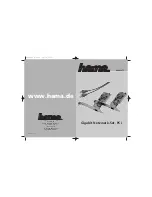
PCX442HR, PCX442e, PCX422HR, PCX422e, PCX440HR, PCX440e
User Manual
7
Main software features
•
Real-time, simultaneous record and playback in PCM (8, 16 and 24 bits) as
well as in MPEG Audio Layer I, Layer II and Layer III
L
, Float IEEE754
conversion supported (with 24-bit fixed-point dynamic range)
•
When using the np SDK, real-time mixing of several PCM and MPEG
audio streams, direct monitoring, level adjustment, panning, cross-fades,
punch-in/punch-out, scrubbing, time-stretching, pitch-shifting, 3-band
parametric equalizer, maximizer, format and frequency conversions
•
Low latency DirectSound, Wave
∗∗∗∗
, and ASIO drivers. Under DirectSound
and ASIO, the cards operate in PCM mode only (nevertheless, an
application can integrate coders/decoders on the host PC). Under Wave,
HR boards can operate in both PCM and MPEG (layer 1 and layer 2).
L
MPEG Layer III play-only on DSP;
MPEG Layer III recording on the host computer is available through Digigram’s
PC Codec using the np SDK
REQUIREMENTS
Minimum hardware requirements
PCX442HR, PCX422HR, and PCX440HR:
PC with one free PCI or PCI-X slot (5 V or 3.3 V).
PCX442e, PCX422e, and PCX440e:
PCI EXPRESS
™
(PCIe®) slot (x1, x2, x4, x8, x16 or x32).
CPU power and memory required depend on the operating system and on the
audio application used.
∗∗∗∗
Windows XP and Server 2003 only; for Windows Vista, a Wave driver is available on request.








































